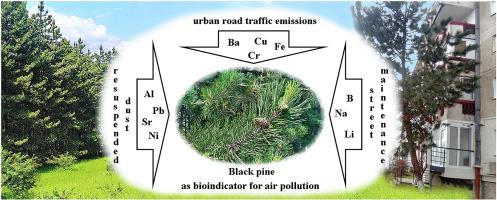Environmental Pollution ( IF 7.6 ) Pub Date : 2021-09-27 , DOI: 10.1016/j.envpol.2021.118228 Andreea Rebeka Zsigmond 1 , Alpár Száraz 1 , István Urák 1

|
Urban activities intensify air pollution by increasing the amount of particulate matter (PM). The trees collect PM by adsorption on the leaf surface and simultaneously absorb inorganic components. In this research, we investigated the potential of the black pine as bioindicator of road traffic emissions in Cluj-Napoca (Romania). We defined three sites types with different exposure to the road traffic (streets, outskirts, parks) and a control site far from the city. We quantified 17 inorganic components (Al, B, Ba, Ca, Cr, Cu, Fe, K, Li, Mg, Mn, Na, Ni, P, Pb, Sr, Zn) by MP-AES (microwave-plasma atomic emission spectroscopy) technique in the one-year-old needles and we identified the best candidates for biomonitoring purposes.
The concentration of Ba, Cr, Cu and Fe showed the most sensitive variations with the road traffic intensity. While in the streets the Ba, Cu and Fe increased by 2.8–3.5 times in relation to the control site, the Cr varied in the highest degree exhibiting ratios of 2.2 (parks), 3.3 (outskirts) and 6.3 (streets). The success of these elements lies in several characteristics: they are closely related to non-exhaust emissions, they are readily absorbed through the leaves rather than the roots, and they tend to accumulate in the needles instead of being relocated to other organs. The street maintenance activities caused considerable accumulation of Na in the trees from the roadsides, but had no impact over the trees from the parks. The elements originating mainly in the resuspended urban dust (Ni, Pb, Sr) equally affected the pines from the streets and parks.
中文翻译:

黑松针中的宏量和微量元素作为城市交通排放的无机指标
城市活动通过增加颗粒物 (PM) 的数量来加剧空气污染。树木通过吸附在叶子表面上收集 PM,同时吸收无机成分。在这项研究中,我们调查了黑松作为 Cluj-Napoca(罗马尼亚)道路交通排放生物指标的潜力。我们定义了三种不同暴露于道路交通的站点类型(街道、郊区、公园)和远离城市的控制站点。我们通过 MP-AES(微波等离子体原子发射)量化了 17 种无机成分(Al、B、Ba、Ca、Cr、Cu、Fe、K、Li、Mg、Mn、Na、Ni、P、Pb、Sr、Zn)光谱)技术,我们确定了用于生物监测目的的最佳候选者。
Ba、Cr、Cu 和 Fe 的浓度随道路交通强度的变化最为敏感。而在街道中,Ba、Cu 和 Fe 相对于对照站点增加了 2.8-3.5 倍,而 Cr 的最高程度变化为 2.2(公园)、3.3(郊区)和 6.3(街道)。这些元素的成功在于几个特点:它们与非尾气排放密切相关,它们很容易通过叶子而不是根部被吸收,并且它们倾向于在针叶中积累而不是转移到其他器官。街道维护活动导致路边树木中大量的钠积累,但对公园的树木没有影响。主要来源于城市重悬浮灰尘的元素(Ni、Pb、











































 京公网安备 11010802027423号
京公网安备 11010802027423号